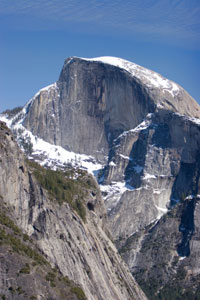
The Yosemite National Park Quarter was released on June 6, 2010 as the third coin of the America the Beautiful Quarters Program. The site is located in the state of California and was federally designated on October 1, 1890.
The reverse design features a view of El Capitan. The granite cliff rises more than 3,000 feet above the valley floor, making it the largest monolith of granite in the world. The inscriptions read “Yosemite”, “California”, “2010”, and “E Pluribus Unum”. The reverse was designed by Joseph Menna and sculpted by Phebe Hemphill.
The Philadelphia and Denver mint produced 35,000,000 coins each. Proof and Silver proof coins were produced at the San Francisco Mint.
The United States Mint formally introduced the Yosemite National Park Quarter during a ceremony held at the park on July 29, 2010. The US Mint Director Edmund Moy and National Park Service officials hosted the event for the third release within the series of America the Beautiful Quarters.
“With this quarter, the United States Mint connects America to the wonder, peace and beauty of one of its most awe-inspiring natural treasures – Yosemite National Park,” Moy told the crowd.
After the formal ceremony, attendees were able to exchange their currency for rolls of the new Yosemite Quarters. Although limits were imposed, multiple passes through the exchange line were permitted, allowing most people to obtain all they wanted.
Yosemite Quarter Mintages
- 2010-D Yosemite Quarter: 35,000,000
- 2010-P Yosemite Quarter: 35,000,000
Yosemite Quarter Specifications
- Designers: John Flanagan (obverse), Joseph Menna (reverse)
- Composition: 91.67% copper, 8.33% nickel (clad), 90% silver, 10% copper (silver proof)
- Diameter: 24.26 mm
- Weight: 5.67 grams
- Thickness: 1.75 mm
- Edge: Reeded
About Yosemite National Park

Native Americans known as the Ahwahneechee were the first to call the area that we now know as the Yosemite Valley their home. It was not until the California gold rush of the 1850’s that non-native peoples had the pleasure of learning about this area’s stunning beauty and diversity. Word of the breathtaking scenery and wide open spaces brought those that would seek to preserve the wildness and splendor of the area. As early as 1855, a homesteader named Galen Clark had already discovered and dedicated his life to protecting the magnificent Giant Sequoia trees that exist in the Park, many of which are still standing today thanks to his activism.
As more and more people moved to the area, many conservationists and naturalists became concerned about the negative impact that development and human population was having on the delicate ecosystems of the valley. In 1890, two famous and influential protectors of natural spaces, John Muir and Robert Underwood Johnson launched a campaign that would eventually convince Congress that the area needed protection from the government.
On the first day of October in 1890, the two celebrated as Congress agreed to set aside over 1,500 square miles of forest land that would soon be referred to as the Yosemite National Park that we know and love today. It would not take the name until 1916, however, when the newly formed National Park Service took over protection of the park from the United States Cavalry.

